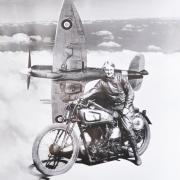As the sun comes out and the temperatures begin to climb, many of us will be heading to the coast to make the most of the summer. But spare a thought for the men and women giving their time to make sure we are safe at sea. Charles Williams praises the RNLI

The RNLI has protected the coastlines of Hampshire and the Isle of Wight since the mid-1800s, and the presence of the emergency service charity today is as essential as it was back then. In 2015, volunteer crews from local lifeboat stations launched 392 times, rescuing a total of 487 people. According to precise RNLI criteria, eight of those rescued were classed as lives saved, meaning that without RNLI intervention, all eight would have died. Alongside the charity’s maritime rescue responsibilities, its other roles include flood rescue, lifeguarding on beaches, and safety education.
The incidents the RNLI respond to each year here can include search and rescue, grounded vessels, kite and windsurfers in distress, or swimmers in trouble. In 2015, Calshot was the busiest station in the area, launching 88 times, rescuing 101 people and saving three lives.
Last year also saw local crews tackling large-scale rescues. On the night of 3 January 2015, the Singapore-flagged car carrier Hoegh Osaka ran aground on the Bramble Bank in the Solent, triggering a multi-agency response including RNLI lifeboats from Calshot, Yarmouth and Cowes, RAF, police and HM Coastguard helicopters, ambulances and four tugs. 24 crew members were plucked from the water by lifeboat crews or airlifted off the ship, which was listing at 45 degrees.
“This is not the sort of call out you expect on a Saturday evening but we had a brilliant response from the RNLI volunteer crews and all the other agencies involved, resulting in the successful rescue of all the ship’s crew,” said Tom Pedersen, helmsman at Calshot Lifeboat Station. “Fortunately, the rescue helicopters managed to winch most of the crew to safety in quite challenging conditions, while two people were rescued by the Calshot RNLI lifeboats. One of them leapt around eight metres from the ship into the water and was picked up immediately by our inshore lifeboat. The other was rescued from the bow of the ship.”
On 30 March, multiple lifeboats were again called out, as crews from Lymington, Cowes and Calshot went to the aid of a capsized Fawley Refinery tug in Southampton Water. With one of the tug’s crewmen missing, the lifeboats searched the area until the man was spotted, holding out in an air pocket in the tug’s wheelhouse. After one of the man’s colleagues broke the window and pulled him clear, RNLI crew members jumped into the water to assist both casualty and rescuer, before providing medical care.

There are seven RNLI lifeboat stations in Hampshire and the Isle of Wight, at Portsmouth, Calshot, Lymington, Hayling Island, Cowes, Yarmouth and Bembridge, equipped with various boats for different conditions. These boats fall into two categories: all-weather and inshore. Highly manoeuvrable, an inshore lifeboat (ILB for short) can operate in shallow water, among rocks, and in narrow spaces like caves, unlike its much larger all-weather counterpart. Examples of ILBs include D Class boats like Hayling Island’s Amanda, James and Ben and Lymington’s B class Atlantic 85 boat, David Bradley. ILBs carry communication and navigation equipment, as well as first aid and night-vision gear.
The biggest vessels in the RNLI fleet are all-weather lifeboats, or ALBs, whose six classes take their names from rivers around the British Isles (Shannon, Trent, Tyne, Mersey, Severn and Tamar). There are two ALBs in this area, at Yarmouth and Bembridge. Bembridge Lifeboat Station houses the Tamar Class Alfred Albert Williams, which is capable of re-righting herself inside six seconds should she capsize, acts as mother ship to a tiny Y Class ILB, and carries extensive communication, navigation and medical equipment. She comes into her own when carrying survivors – her full capacity is 118, although the self-righting capability only applies when carrying 44 or fewer.
Up to 60 percent of the lifeboats required by the RNLI are made on the Isle of Wight, at the Inshore Lifeboat Centre (ILC) manufacturing facility in East Cowes. The ILC, which welcomes visitors for booked tours, has also supplied boats to the Dutch and Icelandic lifeboat services and the Irish Coast Guard. The RNLI’s use of Cowes for boat-building can be traced back to 1913, with the construction of pulling and sailing lifeboats by S.E. Saunders. The hulls and decks of all-weather lifeboats are currently moulded at RNLI SAR Composites in Lymington, although this will move to the charity’s Poole headquarters before 2019.
Training is a crucial element of a lifeboat crew’s routine, as volunteers familiarise themselves with state-of-the-art equipment, both at the RNLI College in Poole, Dorset, and in situ at local lifeboat stations. For instance, Portsmouth Lifeboat Station recently practiced on a dedicated RNLI ‘capsize lifeboat’, which gives crews the opportunity to practice the righting and restart techniques required should they ever capsize. Regular training at any station might involve medical drills, mechanical and navigational exercises, or practicing towing stricken craft.
A fundamental part of the RNLI’s modern role lies in promoting maritime and coastal safety. This can involve classroom visits by volunteers, school trips to lifeboat stations, or lifeguards making beachgoers aware of potential dangers. Surveys conducted at Cowes Lifeboat Station highlight the effectiveness of this prevention work among the public. During a three-hour count in 2015, 52 percent of seagoers passing the station wore lifejackets, as opposed to 47 percent in 2014 and 39 percent in 2013. “By wearing a lifejacket a person who finds himself or herself in the water has more chance of being recovered alive, instead of drowning or dying because of cold water shock,” said David Davies, coastal safety officer at Cowes.

Besides education work, the RNLI is also responsible for maintaining safety at local and international maritime events in Hampshire and the Isle of Wight, as demonstrated when Portsmouth hosted the Americas Cup World Series sailing last summer. Portsmouth and Bembridge patrolled during the event, also joining the local coastguard helicopter in a casualty winching display. June 2015 also saw Cowes’ Atlantic 85 ILB Sheena Louise taking on a marshalling role at the Bicentennial of the Royal Yacht Squadron.
Cowes RNLI’s royal link began in 2012 when the Queen opened its new lifeboat station during her Diamond Jubilee celebrations. This was in fact the first RNLI station that she had opened during her reign. Yarmouth Lifeboat Station also boasts an illustrious connection of its own in world record-breaking yachtswoman Dame Ellen MacArthur, the new chairman of Yarmouth RNLI’s Management Committee.
While volunteer lifeboat crews and lifeguards are at the heart of the RNLI’s rescue mission, their ability to operate depends on legacies, donations, and the efforts of the charity’s fundraisers. Among the latter are Bembridge’s Fundraising Guild, who man an RNLI shop and whose fundraising includes coffee mornings and raffles. In 2015, the Guild raised more than £149,500. Local outdoor fundraising events include Lymington’s annual 10km Race.
“When someone gets into trouble there is always a highly-trained lifeboat crew, a lifeguard, or a Flood Rescue Team ready to lend a hand, no matter how tough the conditions, or how challenging the rescue,” said RNLI Chief Executive Paul Boissier, himself a Hampshire resident. “Much of the funding that we need to make this happen comes from volunteers who work tirelessly for the RNLI, giving their time, organising events, setting up stalls, collecting outside supermarkets or running RNLI shops… but always with that big smile and the warm welcome that is the hallmark of the RNLI.”
READ ON
• National protection for three areas off the Hampshire and Isle of Wight coast - Three areas off the coast of Hampshire and the Isle of Wight are set to get national protection for the special wildlife they support thanks to campaigning by the Wildlife Trusts and their supporters says Tim Ferrero from HIWWT



























